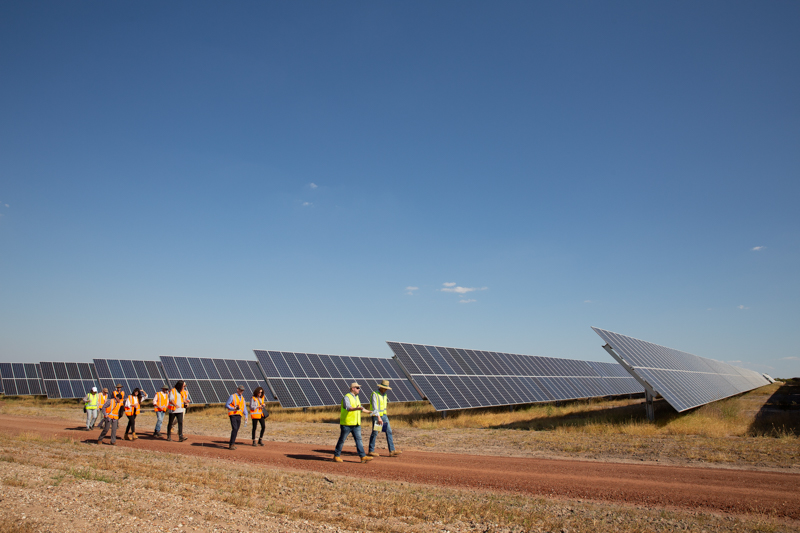The Clean Energy Finance Corporation (CEFC) has committed up to $50 million in debt finance to Infradebt to invest in greenfield renewable projects with a capacity no bigger than 25 MW. Since projects of this scale can be constructed close to the load and grid connections, the new investment push aims to benefit regional communities and industrial and commercial energy users.
According to CEFC, the finance will help close an investment gap in the renewable energy sector for smaller utility-scale projects valued between $10 million and $50 million. Such projects can struggle to raise debt finance because the minimum loan requirements of most institutional financiers are better suited to larger projects, which can deliver greater economies of scale.
“Australia is a world leader in financing rooftop solar PV, as well as very large-scale solar developments, of 50 MW or more. Projects of 25 MW or less can also play a critical role in our clean energy transition,” CEFC CEO Ian Learmonth said.“Projects of this scale are also attracting increasing interest from industrial and commercial energy users, who have the space and the energy demand to warrant investment in their own energy supply.”
Through its new mandate with Infradebt, the CEFC will invest alongside the Infradebt Ethical Fund (IEF), an ethically-screened infrastructure debt fund that finances Australian infrastructure projects with a focus on renewable energy and social infrastructure. The fund was established in 2017 with a $50 million cornerstone commitment from Future Super and plans to specialize in providing debt security to solar and wind projects developed on a merchant basis.
The CEFC’s commitment will increase Infradebt’s committed discretionary capital by 50%, to about $150 million, with the potential to finance a total of more than 100 MW in new clean energy developments. According to Infradebt Chief Executive Officer Alexander Austin, the CEFC investment will help the fund strengthen its focus on an under-utilized segment of the renewable energy market.
“Our aim is to give superannuation funds and other long-term investors the opportunity to make a positive social and environmental impact at the same time as they enhance returns from the defensive part of their portfolio,” Austin said. “We know the renewable market and we work with projects that are usually too small to obtain finance from traditional banks. That experience and point of difference has helped deliver solid returns in the past two years.”
Under the new mandate, the Canberra-based infrastructure fund manager has already closed an $8.5 million senior debt facility with German EPC Enerparc for its 5 MW solar farms at Trundle Hill and Peak Hill in New South Wales. Construction for both projects is already underway and is expected to be completed in Q2 2020. When operational, each farm is expected to generate 28,000 MWh of energy a year, enough to power 4,000 homes.
Enerparc established its Australian operations in 2017 and has a strategy of developing, building and owning a portfolio of solar PV plants across the eastern states. In Europe, the EPC firm operates as a substantial independent power producer owning over 1.7 GW of solar PV plants in Europe. “It’s great to have senior debt finance in place for Peak Hill and Trundle,” said Ben Hannig, Managing Director of Enerparc Australia. “We look forward to continuing to build our portfolio of Australian projects in partnership with Infradebt.”
The transaction marks the 22nd and 23rd project financed by the Infradebt Ethical Fund since its first close in September 2017. The IEF has a portfolio of 22 projects, including the 20 MW Chinchilla Solar Farm and the 34.5 MW Brigalow Solar Farm in Queensland, the 20 MW Swan Hill Solar Farm in Victoria developed by Impact Investment Group and two 5 MW projects in South Australia developed by Indonesia’s Terregra Renewables. All these solar farms are being developed or operated on a merchant business model, selling electricity into Australia’s spot market.
The Canberra-based fund manager also financed solar projects that provide power to Alice Springs and the Voyages resort at Uluru, as well as microgrids meeting up to 80% of the daytime energy needs of the remote Northern Territory communities of Lake Nash, Ti Tree and Kalkarindiji.
This content is protected by copyright and may not be reused. If you want to cooperate with us and would like to reuse some of our content, please contact: editors@pv-magazine.com.









By submitting this form you agree to pv magazine using your data for the purposes of publishing your comment.
Your personal data will only be disclosed or otherwise transmitted to third parties for the purposes of spam filtering or if this is necessary for technical maintenance of the website. Any other transfer to third parties will not take place unless this is justified on the basis of applicable data protection regulations or if pv magazine is legally obliged to do so.
You may revoke this consent at any time with effect for the future, in which case your personal data will be deleted immediately. Otherwise, your data will be deleted if pv magazine has processed your request or the purpose of data storage is fulfilled.
Further information on data privacy can be found in our Data Protection Policy.